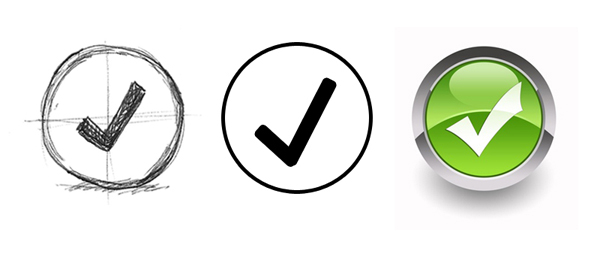If you’ve been around any software development projects then there is a good chance that you’ll have seen wireframes. Some sketched, maybe some mocked up in prototyping tools or crafted in photoshop. They are a popular tool to help conceptualise page layouts or even go as far as to demonstrate interactions in an application.
The level of detail or interaction that is present in a prototype is often described as fidelity. Fidelity is the degree of closeness to the “depth, breadth and finish of the intended product” (Hakim & Spitzer) [1].
To help explain the difference between low and high fidelity the following definitions are from Usability First:
low-fidelity prototype
a prototype that is sketchy and incomplete, that has some characteristics of the target product but is otherwise simple, usually in order to quickly produce the prototype and test broad concepts. [2]
These are the prototypes that you’d sketch in your notepad when describing the layout of a page or the interaction of an element with a colleague. You may capture them in a meeting with a client as a visual record of what has been discussed, so that you can work them up later into a design concept or higher fidelity prototype.
high-fidelity prototype
a prototype that is quite close to the final product, with lots of detail and functionality. From a user testing point of view, a high-fidelity prototype is close enough to a final product to be able to examine usability questions in detail and make strong conclusions about how behavior will relate to use of the final product. [2]
Unlike the quick sketch in your notebook, a high-fidelity prototype is at the other end of the scale. It’s likely to be rich with interaction, styled graphics and layouts that give the appearence of the finished product.
These are the two extreme end of the scale and in reality you will often be working somewhere between them. Some prototypes will have interactions but not so much visual treatment. Others will be worked up to a high level of design treatment but are just flat images, produced in photoshop with some image regions placed over the navigation to give the impression of a clickable ‘wired-up’ prototype. The reality is that often prototypes are just the vehicle to help us prove a concept or elicit requirements. They are not the end goal, just a means to help you reach it, so we take them as far as we need to go – as far as they remain useful and then we stop and move into code. Your choice about whether you go with a low vs high-fidelity approach is likely to be based on a time/cost/benefit decision, and each project is likely to be different.
There is nothing wrong with low or medium fidelity prototypes. I’ve worked on a number of great projects where this level of prototyping has generated some real rewards for all parties involved. However, more recently I have been working with very high-fidelity prototypes in two new ways. They are:
- JAD sessions
- Task based user testing
1. JAD Sessions
The purpose of a JAD session is to dramatically reduce the timeframe required to complete a deliverable where consensus is required by getting all of the major decision-makers, stakeholders, and knowledge providers into one place all at the same time.
The real-time production of a prototype during a JAD can help stimulate the discussion, capture decisions and demonstrate ideas and concepts to non-technical stakeholders.
Questions like, “What fields do we want to be capturing during the signup process” are easily answered when a marketing representative is present along with your database administrator. Consensus is reached and the prototype is updated to reflect this detail. The designer gives his input on the layout and one of the developers is able to highlight a constraints of the existing technology stack used. And then you move on to the next decision.
The prototype acts as the living record. The organic deliverable that in the space of 2 or 3 days has grown to encompass all the requirements, decisions and actions.
Task-based User Testing is all about learning how users interact with your application or website in order to access information and complete tasks. Nielsen states that the biggest improvements in user experience come from gathering usability data as early as possible. He estimates that it’s 100 times cheaper to make changes before any code has been written than to wait until after the implementation is complete [3]. With this in mind it’s important to get user feedback and research findings as early in the process as possible, waiting until the site or application is live can be costly and impracticable.
While the prototype is not the finished product it’s important that it is worked up to a very high fidelity so that users are comfortable with its look and feel and aren’t distracted by inconsistent elements or broken interactions. The prototype requires a high level of polish and a set of well crafted scenarios to test and journeys through the prototype.
Working a prototype up to the is degree of fidelity requires time and skill but it’s a worthwhile investment to ensure that you can capture user feedback in the design phase, before any code is written.
Conclusion
Prototyping at any level will give you a great return. Your decisions on how close to make it to the finished product will depend on your budget, your deadline and the influence you are trying to achieve with it.
[1] Farnum, Chris. 2009. “What you should know about prototypes for user testing.” [online]. Published on 29th July 2009. http://www.boxesandarrows.com[2] “Usability First, Glossary”. Accessed on 11th July 2012. http://www.usabilityfirst.com/
[3] Nielsen, Jakob. 2003. “Paper Prototyping: Getting User Data Before You Code.” Published on 14th April 2003. http://www.useit.com
